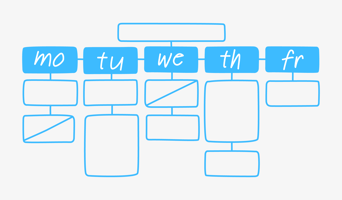
Stressed, exhausted and overwhelmed. Unfortunately, these feelings have become a widespread workplace issue, especially in schools. Research suggests that teaching, in particular, is a profession characterized by high rates of burnout and emotional exhaustion. A recent Gallup study in the U.S. showed that K-12 educators show the strongest sign of burnout across all examined industries. However, burnout does not only affect educators’ wellbeing, mental health and job satisfaction, it also takes a toll on student learning and adjustment.
Teacher workload is increasing, creating overwhelm and exhaustion.
When work starts feeling unpleasant, unfulfilling, and unrewarding, you’re at a high risk for developing burnout. Burnout typically has three dimensions: exhaustion, lack of accomplishment, and feelings of cynicism towards and detachment from the job. Hereby, emotional exhaustion, or the feeling of being emotionally drained and worn-out, is a central aspect. Nevertheless, it is the abundance of challenges and the complexity of coordination that creates overwhelm for today’s educators. The overnight adaption to a remote learning environment throughout Covid, and navigating the uncertainties from student, school, and private life perspectives, are certainly an extreme example how teacher stress can be triggered. But the daily school life, where teachers have to constantly coordinate as part of various teams, making sense of new development initiatives, has also become a serious source of stress that one should not underestimate. As the world around us is moving increasingly fast, making sense of the implications of innovations like Chat GPT, or now Bard AI, also adds to the already heavy burden schools face.
Mindfulness is a coping strategy – not the long-term solution to improve teacher mental health.
While there are ways to notice and treat teacher burnout symptoms individually like practicing awareness and mindfulness techniques, these coping strategies only touch the surface rather than creating a long-term solution to deal with increased uncertainty and future challenges. It is therefore vital that school administrators provide a supportive environment and adequate guidance for teachers to ease their overwhelm, as well as regain their sense of purpose and fulfillment before it’s too late.
Time to prioritize the well-being of your school?
Start a conversation
Preventing teacher burnout requires organization and leadership development.
One part of holistically approaching teacher well-being is encouraging a school culture of collaboration, open communication, and constructive feedback. Strong relations improve resilience and help people get help when they need to. Learning builds on social relationships and it is natural that educators focus on that perspective. Nevertheless, cultures in schools are very fluid. Against the backdrop of so many cultures coming together and the constant transitions in the community, culture changes all the time. Without building clear organizational structures around culture, development will too much depend on individual interpretations – and can even create a higher burden.
This is why there is a need for a more holistic perspective, considering the entirety of collective skills, abilities, and expertise of an educational organization. How you bring people and resources together to accomplish what your school stands for. Therefore, treating the organization as a whole, not just building on scattered pockets of good practice, in one department or at the senior leadership level.
For example, a teacher today is typically part of three to five teams, sometimes even more. An honest reflection will show that schools typically create additional (micro) teams, instead of revising the team structures and purpose. Too often, these teams still communicate and collaborate in silos instead of being closely linked. The same applies to decision-making. Many educators state they feel that discussions drag on for too long and that decision-making is too slow. This is often due to a lack of structures and guidance to enable easier communication, collaboration and feedback. Ultimately, this leads to unclear expectations, overwhelm and feelings of isolation for individuals – the precursors for burnout.
Therefore, it is crucial to support school leaders in finding time to implement more efficient structures through reflection on, e.g.:
- What are the relevant perspectives on learning that you derive from your school’s purpose and strategy?
- What teams do you need to cover these perspectives and why?
- How can these be most effectively linked for collaboration?
- What does that mean for coordination needs, responsibilities, and leadership?
Finally, the overall goal should be to empower the individuals in the school that are asked to take responsibility through leadership – almost all of them are educators by training. So you need a leadership development strategy for them to start working with the right tools in order to be able to build the necessary structures for supporting teacher well-being and creating the next successful chapter for your school.
Channel your full energy into building a better school
Learn more about our leadership journey


